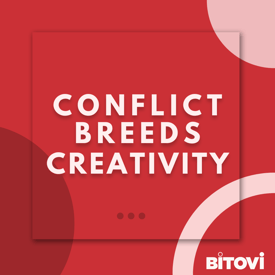In This Series: Conflict-Free Leadership
- Conflict-Free Leadership: Roles, Goals, & Expectations [Part 1]
- Conflict-Free Leadership: Preventing Conflict [Part 2]
- Conflict-Free Leadership: Emotional Intelligence [Part 3]
- Conflict-Free Leadership: The Value of Retrospectives [Part 4]
- Conflict-Free Leadership: The Framework in Action [Part 5]
While on the surface creating specific roles, goals, and expectations for a new project sounds simple enough, it can be challenging to implement effectively without a proper plan.
Of course, as with anything, it’s important to think of this tool as an ongoing experiment. The level of time it will take to refine this process will vary by project and your level of experience implementing it, but the more frequently you engage with the practice, the more streamlined your process will become.
1. [Pre-Project] Schedule a Meeting
Who is working on the project, and what is the scope of their involvement? What is the ideal end result, and what benchmarks do we set to stay on track? How do we define quality work standards?
Prior to the start of your next project, sit down with relevant parties for a meeting. Whether you’re a consultant getting ready to integrate your team with a new client or you’re stepping into a leadership position in your company, it’s important to have a clear understanding of the functions, personalities, and tools you’ll be working with.
This first meeting is an open dialogue with the intention of getting everyone on the same page when it comes to the roles, goals, and expectations for the project.
Discuss Everyone’s Roles
Have a conversation about everyone’s roles. Ensure each member of the team is clear on who is meant to accomplish what, who the key decision makers are, and the general flow of communication. Roles and titles are in place to be sure your team is not duplicating efforts, stepping into someone’s zone of genius, and that everyone has a teammate to turn to if they have questions or encounter an issue.
Establish the Project Goals
Have a conversation about the goals of the project. In software, we talk about the MVP or minimum viable product. Everyone must have the same clear vision of how this MVP looks and behaves. Otherwise, you’re putting yourself and your team at risk of over-complicating the project, missing deadlines, or incurring unnecessary workloads and stress.
Goals for project management should follow the same principles as they do elsewhere—specific, measurable, attainable, relevant, and time-bound. Having this conversation early on in the process is two-fold; it gives everyone an opportunity to think in-depth about the vision for the project, and it sets measurable standards for how to view the project as it progresses.
Set Clear Expectations
Have a conversation about expectations. Clearly defined expectations are a great way to maintain accountability for all parties. A reliable, exhaustive list of expectations leaves little room for surprises. Don’t just focus on the product! It’s equally important to discuss asynchronous communication and expectations of offline hours. By outlining specific expectations, you are aligning everyone on the project’s definition of work standards and success—leaving little room for guesswork and disappointment.
Continue to Meet Regularly
When it comes to a large-scale software initiative, there cannot just be one meeting to kick things off and one meeting to deliver the finished product. There will be changes, updates, unforeseen issues, timeline tweaks, and questions along the way. It’s important that everyone on the leadership side understands how the process will be monitored.
For example, team leads might have daily stand-ups with their junior developers. Team leads might have a meeting each Friday to report their team’s status and progress to the other leads. Each team lead might also write up a summary report and send it to the product manager each week, and so on and so forth.
While this may feel like a simple, maybe even obvious, workflow, it’s important to be explicit and establish patterns we convey to the entire team. These patterns create better communication flows and make it easier to notice if something or someone may need extra support. If one team lead doesn’t submit their notes to the product manager, that product manager will immediately know to check in with the team lead. This check-in may end up as a reminder to submit notes, or it could reveal a problem that, if gone unnoticed, could have impacted the quality or timeliness of the project.
Implement check-ins with the leadership team to discuss any alterations that may surface during the project. These check-ins will become relevant again in step two.
While this first step may take some time upfront, it has the potential to save time, energy, and money down the line. It’s about clarifying the most important aspects of a project in an effort to maximize the time focused on creating the product itself.
2. [During Project] Implement Check-Ins
How are things going?
During your discussion of expectations, the leadership team should discuss weekly, bi-weekly, or monthly check-ins to discuss progress, ask questions, or course correct, if necessary.
Resist the urge to make these too infrequent or cancel them as the project moves along. The frequency of these communications should be based on the pace of the project. If the project is meant to take a month, weekly check-ins are a good idea. It’s crucial that they’re frequent enough to catch issues almost as soon as they arise or risk stalling the whole project. If a project is meant to take a year, monthly or quarterly check-ins may suffice. As with anything, the frequency and length of these meetings may change as the project continues.
Monitor the process to prevent task conflict. Proactively check for and clarify procedural misunderstandings rather than passively waiting for problems to surface. Checking in with members of the team can help confirm that everyone is on the same page.
Something as simple as, “Beth, once you wrap up that PR, what happens with it next?” A quick question can confirm everyone’s interpretation of the issue at hand is the same. Even if things appear to be going well, it’s important each team member knows that they’re still allowed to have questions. Check-ins and status reports over the course of the project can help mitigate dramatic issues by tackling things the moment they arise.
3. [During Project] Real-Time Assessment
What did we learn from the check-ins? What, if anything, in the process needs to be changed?
Check-ins are only as helpful as the follow-up. Assessing the issues that were brought up or discovered during check-ins can help refine the process in the midst of a project. When taking on new work, carving out time for mid-project assessments gives you the space to anticipate issues and pivot when necessary. Instead of always barreling through a challenge, making an effort to be contemplative is like giving yourself permission to slow down and make informed decisions.
Keep your team in the know. Giving a status update can ease anxiety and boost morale. Even if there are shifts that need to be made, frame those shifts constructively. It’s important not to blame and shame. Instead of, “Since it took Jen so long to implement authentication last week, we’ve had to push the deadline back”, try something like, “Last week, we learned that some seemingly smaller tasks may cause unexpected delays, so we’re going to extend the deadline a week in case another issue comes up”. In the latter statement, you’ve demonstrated your ability to pivot as a leader and made sure the developers understood the reasoning for the change.
By dedicating a given time to digesting those check-in discussions, you’ve left yourself space to make reasonable pivots and convey those decisions to your team.
4. [Post-Project] Reflect
What went well? What could have gone better? How can we keep doing the good stuff? What processes can we change for next time?
Every project should end in a retrospective—what worked well, and where is there room for improvement? Whether a project was completed without incident, felt like a total disaster, or landed somewhere in between, the opportunity to reflect is illuminating.
A retrospective is done between you and the client team, bringing the project full circle. From the first meeting about roles, goals, and expectations to the retrospective, everyone on the leadership team should have a clear view of what worked well and what could have been improved.
Retrospectives can also be valuable internally following a client meeting or sprint. The intention is to fine-tune your skill set. As the leader and decision maker, your process has lasting implications on the people you work with and on the quality of the work they produce. A retrospective or debrief done with your team is an opportunity to relay positive and constructive feedback. Instead of making changes, explain what instances led to the changes. This helps the team understand your thought process, offer their own insight, and feel connected to the way projects are managed.
Effective communication with the client and your own team is the overarching theme. The more precisely we are able to outline the roles, goals, and expectations, the less we leave to misinterpretation and chance. Remember that good communication takes practice, so the more diligent you are in the practice, the more powerful it will become.
Conclusion
Leadership is our ability to move people towards a common goal. By employing the principles of the roles, goals, and expectations framework, we lead by establishing clarity and consent.
 Anticipate that there may be conflict. It’s important to embrace some conflict as positive. It can force us into high-level thinking mode and lead to creative problem-solving. Whether it’s a snazzy recursive function or a clever resolution of some tricky network bug—conflicts can breed creativity. Notice when a conflict is caused by a process and work to fix the process rather than blame a person. Leaders who are capable of recognizing the root cause of an issue are able to find long-term solutions while maintaining a healthy work environment.
Anticipate that there may be conflict. It’s important to embrace some conflict as positive. It can force us into high-level thinking mode and lead to creative problem-solving. Whether it’s a snazzy recursive function or a clever resolution of some tricky network bug—conflicts can breed creativity. Notice when a conflict is caused by a process and work to fix the process rather than blame a person. Leaders who are capable of recognizing the root cause of an issue are able to find long-term solutions while maintaining a healthy work environment.
Every project you work on from now until retirement will bring its own set of challenges, but this framework is flexible. Its aim is to encourage more conversations. Leadership has never been defined as knowing it all. It’s about being capable of creating a clear path to the finished product and helping maintain the path along the way. The ability to empathize, anticipate, and pivot are hallmarks of a successful leader. Try it out. You might be surprised how much you can accomplish.
What do you think? Drop into our Community Discord and let us know how this framework feels for you, or tell us about any alternative approaches you practice in your workspace!
Previous Post




